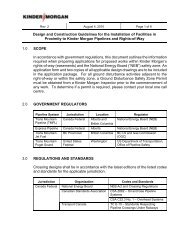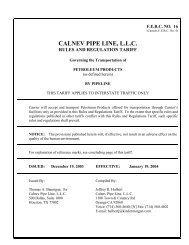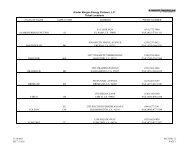Winterization Plan - Kinder Morgan
Winterization Plan - Kinder Morgan
Winterization Plan - Kinder Morgan
You also want an ePaper? Increase the reach of your titles
YUMPU automatically turns print PDFs into web optimized ePapers that Google loves.
drainage, and stabilized as best as practicable prior to the commencement of the winter construction perioduntil conditions allow for the final grading to be achieved.• In sections of ROW where topsoil segregation was completed, the topsoil piles would be left in theirstabilized condition and replaced in the spring when the weather conditions permit the properdecompaction of the areas. The exposed subsoil would be seeded with a winter seed and mulched tominimize erosion-related problems. The mulch should be in good condition and care taken to avoidutilizing any mulch containing noxious weed seed.• In all Project areas, as the condition of the ROW permits, all temporary and/or permanent slope breakerswould be installed consistent with the approved erosion control plans and Commission and other agencyrequirements, and in any other locations where the EI staff and/or Tennessee believes that slope breakerswould be necessary. The contractor would be responsible for ensuring the slope breakers are of sufficientsize and outflow angle to successfully transport run-off into sediment traps (temporary slope breakers) off-ROW, or into straw bale or silt fence “J-Hooks” located at the ends of the breakers.• All areas will be seeded with 50 pounds per acre of an annual winter seed. At the contractor’s discretion,application of the final seed mix (in addition to the annual seed) would continue, provided that in the eventthe final seed mix does not germinate in the spring, over seeding of these areas of insufficient germinationwill be completed.• All disturbed Project areas will be mulched at a rate of 3 tons per acre. .• Timber mats may be left in the wetlands to allow for travel during final restoration activities. Mats will beremoved from areas prone to flooding so they do not float off-ROW during spring flooding.• The contractor will remove equipment bridges and if necessary, leave enough bridge mats at each location toallow for the installation of an equipment bridge adequate to allow crossing of equipment and vehicletraffic needed for final cleanup and restoration. Stream banks will be restored and stabilized in accordancewith the ECPs following the removal of equipment bridges.• The contractor will leave access pads and temporary fence gaps in place. The removal of the access pads andthe installation of permanent fencing will be performed as part of final restoration activities.7.0 POST-CONSTRUCTION WINTER MONITORINGOnce the proposed cleanup, restoration, and <strong>Winterization</strong> activities have been completed for 2011, Tennessee willcontinue to maintain the appropriate erosion and sedimentation controls as needed during the winter period.Tennessee representatives, as identified above, will be available during this time to address erosion issues andlandowner concerns that may arise.During the anticipated winter shutdown, Tennessee will inspect the ROW on a regular basis (minimum of biweekly)and identify where erosion control measures are damaged or are ineffective, and where corrective measuresneed to be taken when conditions allow. The extent of inspections will be based on precipitation events, runoffamounts, and thawing. Where frozen conditions persist for long periods of time, regular inspections may not benecessary. When snow melts or the ground thaws, the potential for erosion increases and the frequency ofinspections would increase.The inspections will pay particular attention to Winterized areas, environmentally sensitive areas such as steepslopes, wetlands and waterbodies, road crossings, and residential areas. These inspections will identify:• Erosion control structures requiring maintenance and/or repair.• Areas of slope instability.• Areas where significant levels of erosion are occurring.• Revegetation success.4
















